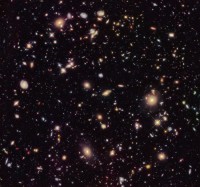Astronomers explore golden age of galaxies

An international team of astronomers, led by Edinburgh, has gained a new view of the evolution of distant galaxies. Their study focuses on a region of the Universe previously studied using the deepest observations of the Hubble Space Telescope.
The team has traced the previously unknown abundance of star-forming gas and dust over cosmic time. This provides new insights into what is known as the golden age of galaxy formation - approximately 10 billion years ago. The new observations of a well-studied area of sky, known as the Hubble Ultra Deep Field, were taken with the ALMA (Atacama Large Millimetre/submillimetre Array) telescope, located high in the Atacama Desert in Chile. The resulting images are significantly deeper and sharper than those from previous surveys undertaken at these long wavelengths. Astronomers have used their findings to show for the first time how the rate of star formation in young galaxies is closely related to their total mass in stars, which is assembled from previous star-formation events.
The findings will be published in in the Monthly Notices of the Royal Astronomical Society.
The first Hubble Ultra Deep Field images, pioneering deep-field observations at optical wavelengths, were captured with the NASA/ESA Hubble Space Telescope and published in 2004. Hubble was refurbished in 2009 and since then, it has captured near-infrared images. The result is the deepest view of the Universe to achieved date, revealing early galaxies that existed less than a billion years after the Big Bang. However, Hubble cannot reveal the emission from young stars that is absorbed and then re-emitted by clouds of interstellar gas and dust, within which the youngest stars form. To do this, astronomers have had to await the advent of ALMA, which for the first time enables the warm glow of dust-enshrouded star-formation activity to be imaged with a depth and clarity comparable to Hubble imaging. The team, led by the University of Edinburgh, used ALMA to obtain the first deep, homogeneous image of the entire Hubble Ultra Deep Field region. This enabled them to clearly match the galaxies detected by ALMA with objects already known from the Hubble imaging. This showed clearly, for the first time, that the mass of stars already existing within a galaxy is the best indicator of how quickly stars are forming in the very distant Universe. The team was able to detect virtually all of the high-mass galaxies and very little else.
According to researchers, the new ALMA results imply a rapidly rising gas content in galaxies as we look back further in time. This is likely the root of a remarkable increase in star formation rates during the peak of galaxy formation some 10 billion years ago. The results are the first in a series of planned observations of the distant Universe using ALMA. Astronomers hope the forthcoming program of surveys will complete their view of the galaxies in the Hubble Ultra Deep Field.

